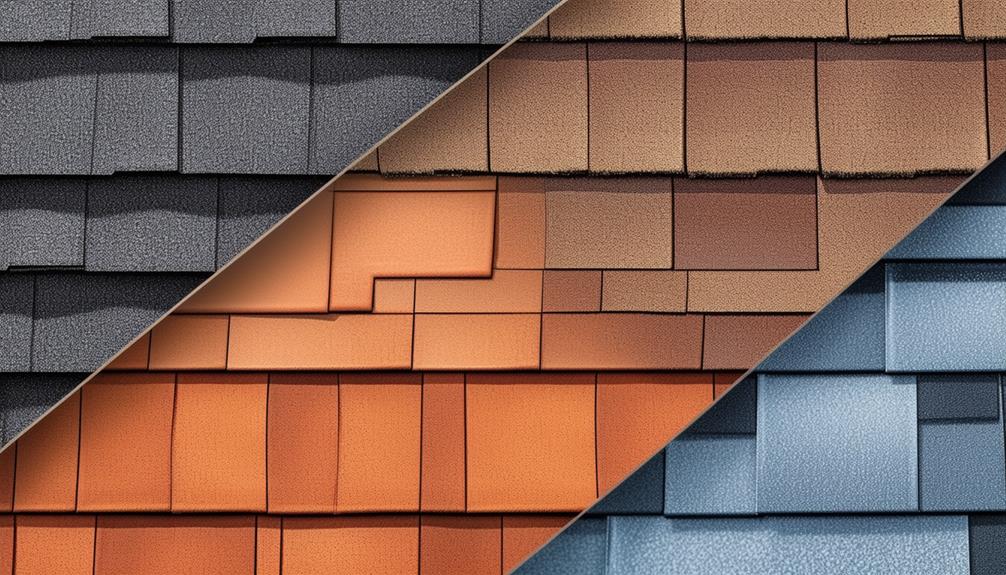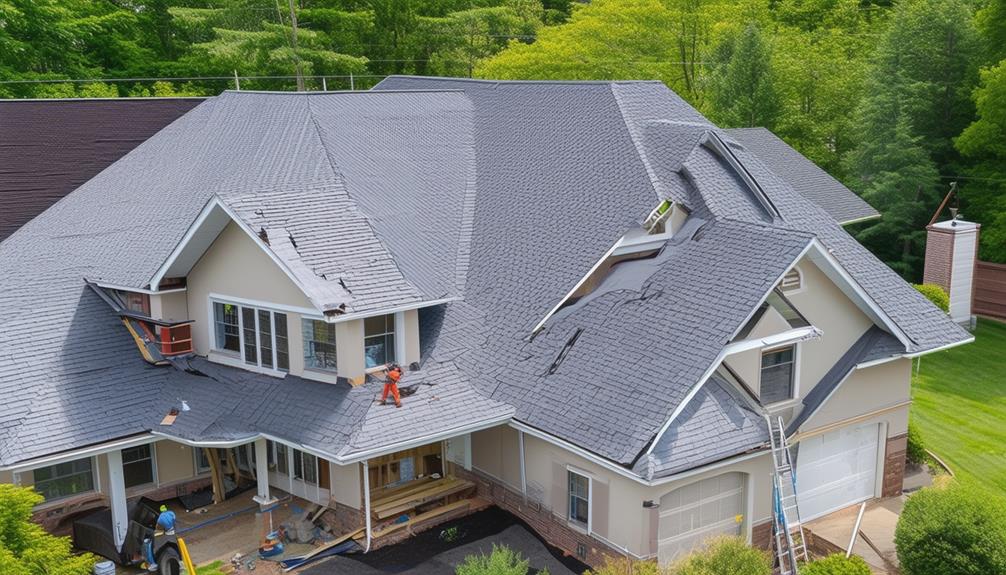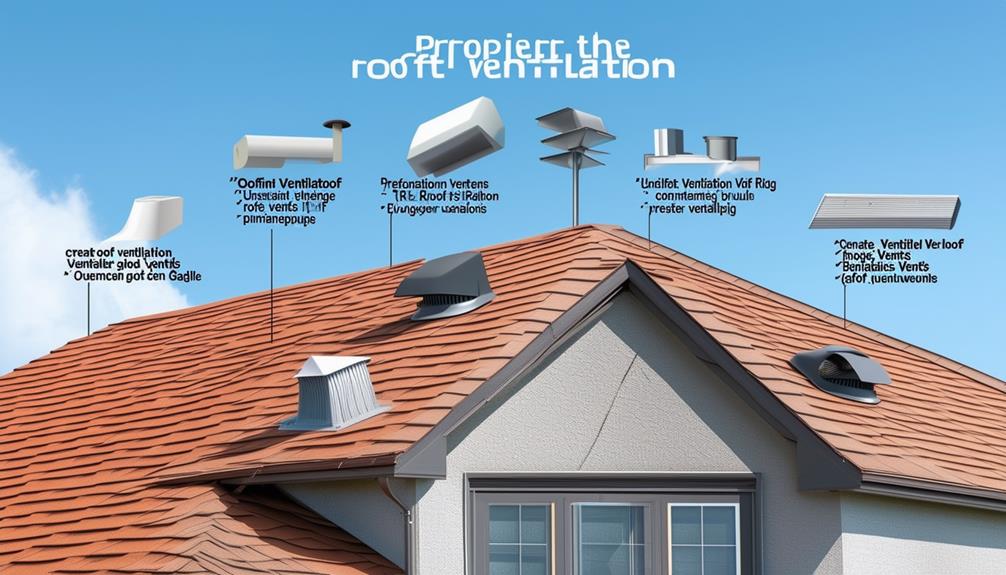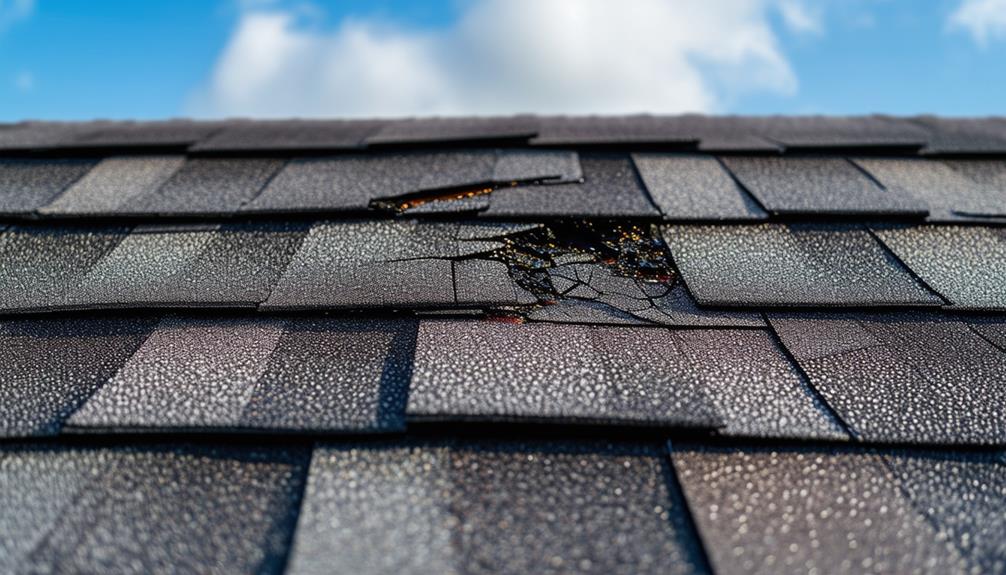If you’re stepping into the roofing world, grasp the fundamental elements. Educate yourself on various roofing materials like asphalt shingles, metal, and clay tiles based on your climate. Familiarize yourself with important terms such as flashing, underlayment, and ventilation. Understand the sequence of the roofing installation process including cost estimation, old roof removal, and safety precautions. Learn about roof pitch, its impact on water runoff, and aesthetic considerations. Discover the significance of roof ventilation for attic temperature regulation and energy efficiency. Begin your journey by absorbing these essential basics to make informed roofing decisions.
 When considering roofing materials for your home, it is essential to explore the various types available to determine the best option for your needs. Two critical factors to evaluate are roofing durability and weather resistance. Durability is vital as it guarantees your roof can withstand the test of time, reducing the need for frequent repairs or replacements. Weather resistance is equally important, especially in areas prone to harsh weather conditions such as heavy rain, strong winds, or extreme temperatures.
Among the various types of roofing materials, asphalt shingles are a popular choice due to their durability and weather resistance. They are cost-effective, easy to install, and come in a variety of colors to suit your aesthetic preferences. Metal roofing is another excellent option known for its longevity and ability to withstand severe weather conditions. Additionally, clay tiles are durable and offer excellent weather resistance, making them ideal for hot climates.
Before making a decision, consider the climate in your area and consult with roofing professionals to determine the most suitable material for your home.
When considering roofing materials for your home, it is essential to explore the various types available to determine the best option for your needs. Two critical factors to evaluate are roofing durability and weather resistance. Durability is vital as it guarantees your roof can withstand the test of time, reducing the need for frequent repairs or replacements. Weather resistance is equally important, especially in areas prone to harsh weather conditions such as heavy rain, strong winds, or extreme temperatures.
Among the various types of roofing materials, asphalt shingles are a popular choice due to their durability and weather resistance. They are cost-effective, easy to install, and come in a variety of colors to suit your aesthetic preferences. Metal roofing is another excellent option known for its longevity and ability to withstand severe weather conditions. Additionally, clay tiles are durable and offer excellent weather resistance, making them ideal for hot climates.
Before making a decision, consider the climate in your area and consult with roofing professionals to determine the most suitable material for your home.
 Familiarize yourself with the roofing installation process to gain insight into the systematic steps involved in constructing a durable and functional roof. Prior to commencing the installation, make sure that proper roofing safety precautions are followed to protect yourself and others. Start by estimating the roofing costs involved, including materials, labor, permits, and any additional expenses that may arise during the project.
The roofing installation process typically begins with the removal of the old roof, followed by an inspection of the roof deck to assess its condition and guarantee it can support the new roofing materials. Next, underlayment is applied to provide a waterproof barrier, followed by the installation of shingles or other roofing materials based on your preference and budget.
Throughout the installation process, it is essential to adhere to safety guidelines, use appropriate tools, and work methodically to achieve a high-quality result. By understanding the roofing installation process and taking necessary precautions, you can ensure a successful and long-lasting roof for your property.
Familiarize yourself with the roofing installation process to gain insight into the systematic steps involved in constructing a durable and functional roof. Prior to commencing the installation, make sure that proper roofing safety precautions are followed to protect yourself and others. Start by estimating the roofing costs involved, including materials, labor, permits, and any additional expenses that may arise during the project.
The roofing installation process typically begins with the removal of the old roof, followed by an inspection of the roof deck to assess its condition and guarantee it can support the new roofing materials. Next, underlayment is applied to provide a waterproof barrier, followed by the installation of shingles or other roofing materials based on your preference and budget.
Throughout the installation process, it is essential to adhere to safety guidelines, use appropriate tools, and work methodically to achieve a high-quality result. By understanding the roofing installation process and taking necessary precautions, you can ensure a successful and long-lasting roof for your property.
 Understanding the significance of proper roof ventilation is essential for maintaining a healthy and durable roofing system. Ventilation benefits encompass a range of advantages that directly impact the longevity and efficiency of your roof. Adequate ventilation helps regulate the temperature in your attic, preventing heat buildup that can lead to moisture issues and damage. It also assists in reducing energy costs by keeping your home cooler in the summer and preventing ice dams in the winter.
Proper ventilation installation is vital to guarantee these benefits are realized. It involves strategically placing intake and exhaust vents to create a continuous airflow that allows heat and moisture to escape from the attic. Intake vents are typically located along the eaves or soffits, while exhaust vents are placed near the roof ridge. This setup promotes air circulation, preventing condensation, mold growth, and premature deterioration of roofing materials. By prioritizing ventilation installation, you can enhance the overall performance and lifespan of your roof.
Understanding the significance of proper roof ventilation is essential for maintaining a healthy and durable roofing system. Ventilation benefits encompass a range of advantages that directly impact the longevity and efficiency of your roof. Adequate ventilation helps regulate the temperature in your attic, preventing heat buildup that can lead to moisture issues and damage. It also assists in reducing energy costs by keeping your home cooler in the summer and preventing ice dams in the winter.
Proper ventilation installation is vital to guarantee these benefits are realized. It involves strategically placing intake and exhaust vents to create a continuous airflow that allows heat and moisture to escape from the attic. Intake vents are typically located along the eaves or soffits, while exhaust vents are placed near the roof ridge. This setup promotes air circulation, preventing condensation, mold growth, and premature deterioration of roofing materials. By prioritizing ventilation installation, you can enhance the overall performance and lifespan of your roof.
 When inspecting your roof, being able to identify signs of damage is essential for maintaining the structural integrity of your home and preventing costly repairs in the future. Some common signs of roof damage include missing, cracked, or curled shingles, water stains on ceilings or walls, sagging areas on the roof, and light entering through the attic. If you notice any of these issues, it’s important to address them promptly to avoid further damage to your roof. Additionally, recurring leaks or extensive shingle loss are often signs you need a roof replacement rather than simple repairs. Ignoring these indications can lead to more severe structural problems, including mold growth and weakened roofing materials. Regular inspections and prompt action are key to protecting your home and ensuring your roof remains in optimal condition.
For repair options, depending on the extent of the damage, you may need to contemplate simple repairs like replacing a few shingles or more extensive repairs such as fixing a larger section of the roof. It’s advisable to consult with a professional roofing contractor to assess the damage accurately and recommend the most suitable repair solution.
In cases where the damage is significant and requires substantial repairs, you may need to file an insurance claim. Document the damage thoroughly with photographs and seek guidance from your insurance provider to understand the claim process and secure proper reimbursement for the repairs needed.
When inspecting your roof, being able to identify signs of damage is essential for maintaining the structural integrity of your home and preventing costly repairs in the future. Some common signs of roof damage include missing, cracked, or curled shingles, water stains on ceilings or walls, sagging areas on the roof, and light entering through the attic. If you notice any of these issues, it’s important to address them promptly to avoid further damage to your roof. Additionally, recurring leaks or extensive shingle loss are often signs you need a roof replacement rather than simple repairs. Ignoring these indications can lead to more severe structural problems, including mold growth and weakened roofing materials. Regular inspections and prompt action are key to protecting your home and ensuring your roof remains in optimal condition.
For repair options, depending on the extent of the damage, you may need to contemplate simple repairs like replacing a few shingles or more extensive repairs such as fixing a larger section of the roof. It’s advisable to consult with a professional roofing contractor to assess the damage accurately and recommend the most suitable repair solution.
In cases where the damage is significant and requires substantial repairs, you may need to file an insurance claim. Document the damage thoroughly with photographs and seek guidance from your insurance provider to understand the claim process and secure proper reimbursement for the repairs needed.
Types of Roofing Materials

Common Roofing Terminology
Explore the world of roofing by familiarizing yourself with common roofing terminology used in the industry. Understanding these terms is essential for effective communication with professionals and guaranteeing the safety of your roofing project. Here are three essential roofing terminologies to get you started:- Roofing Techniques:
- *Flashing*: Thin pieces of metal installed to prevent water seepage around joints and seams.
- *Underlayment*: A protective layer installed beneath the roofing material to shield the roof from water damage.
- *Ventilation*: The process of allowing air to flow through the attic space, regulating temperature and moisture levels.
- Roofing Safety:
- *Fall Protection*: Equipment and measures put in place to prevent workers from falling off a roof.
- *Personal Protective Equipment (PPE)*: Gear like helmets, gloves, and harnesses worn to ensure worker safety.
- *Ladder Safety*: Proper usage and securing of ladders to prevent accidents during roof access.
Roofing Installation Process

Understanding Roof Pitch
To comprehend the concept of roof pitch, consider it as the angle formed by the roof surface in relation to the horizontal plane. Understanding roof pitch is important in determining the suitable roofing materials, drainage capabilities, and overall aesthetics of your roof. Here are some key points to help you grasp the importance of roof pitch:- Roof Pitch Calculation: The roof pitch is calculated by measuring the vertical rise of the roof in inches for every 12 inches of horizontal run. For example, a 4:12 pitch means the roof rises 4 inches for every 12 inches of horizontal run. This calculation helps determine the slope of the roof and influences the choice of materials.
- Benefits of Roof Pitch: A steeper roof pitch allows for efficient water runoff, reducing the risk of leaks and water damage. It also provides more attic space and enhances the overall durability of the roof structure.
- Roof Pitch Aesthetic Appeal, Design: The pitch of the roof significantly impacts the visual appeal and architectural style of a building. Different roof pitches can evoke various design aesthetics, from traditional to modern, adding character and charm to your property.
Roof Ventilation Importance

Impact of Roofing on Energy Efficiency
Proper roofing plays a significant role in enhancing the energy efficiency of your home by effectively regulating temperature and reducing energy costs throughout the year. When pondering the impact of roofing on energy efficiency, it is essential to grasp the insulation benefits and environmental sustainability it offers. Here are three key points to ponder:- Insulation Benefits: A well-insulated roof can prevent heat loss during the winter and minimize heat gain during the summer, creating a more stable indoor temperature. This reduces the workload on heating and cooling systems, leading to lower energy consumption and decreased utility bills.
- Environmental Sustainability: Opting for energy-efficient roofing materials and designs can contribute to environmental sustainability by reducing the carbon footprint of your home. Sustainable roofing options often involve materials that are recyclable, energy-efficient, and durable, promoting a greener living environment.
- Long-Term Cost Savings: Investing in energy-efficient roofing may require an initial upfront cost, but the long-term savings on energy bills and potential tax incentives can make it a financially wise decision. Additionally, sustainable roofing solutions can increase the overall value of your home while benefiting the environment.
Signs of Roof Damage

Roof Maintenance Tips
Wondering how you can effectively maintain your roof to guarantee its longevity and durability? Here are some essential roof maintenance tips to help you keep your roof in top condition:- Regular Gutter Cleaning: Make sure to clean your gutters at least twice a year to prevent clogs that can lead to water backup and potential roof damage. Remove leaves, debris, and any blockages to allow proper water drainage.
- Moss Prevention: Moss growth on your roof can cause moisture retention, leading to potential roof deterioration over time. Trim overhanging branches to reduce shade, which moss thrives in, and consider using zinc or copper strips along the ridge to inhibit moss growth.
- Professional Inspections: Schedule annual inspections by a roofing professional to detect any early signs of damage, such as loose shingles, cracked seals, or damaged flashing. Timely repairs can prevent more significant issues down the line and help extend the life of your roof.




